|
|
Many other case variants of this keyboard were released under a great variety of different brand names (see below). These often have "MC-3" in their model name and were apparently invented in 1988 by the Chinese manufacturer Medeli as their first very successful music keyboard, of that over 90 million units were made (seen on their company description webpage). My version has no "MC-3" label, because it was likely the first model of the Letron brand. But I think that "Letron MC-3" is the genuine full name of this instrument, because later specimen (seen on eBay) were indeed labelled this way, and Letron also released other keyboards with different "MC" number. Beside MC-3 also other squarewave keyboards exist with the same sound hardware and partly even more interesting accompaniment styles, but unfortunately many of these are quite rare and thus difficult to find.
Interesting is also that this thing has less polyphony than the similar Yamaha PS-2, despite the latter came out about 15 years earlier. Unlike predecessors, the MC-3 is technically not pure squarewave anymore (there is an additional grainy sawtooth and spike waveform), but the sound appeal is much the same like squarewave with different pulse widths.
(Note: This keyboard sounds great, but don't buy one of these so far your only intention is to get a keyboard with faithfully imitated natural instrument sounds. Remember, this is a squarewave instrument and thus many of its sounds sound not even remotely like what is written on its buttons, though bought with wrong expectation it may disappoint you.)
| base & conga | = low & higher squarewave blips |
| snare | = shift register noise |
| open hihat | = unique electronic metallic timbre (low- res waveform sample??, or 2 mixed squarewaves?) with truncated decay and audible end click. |
| closed hihat | = dto.' with shorter envelope |
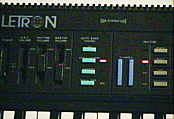 |
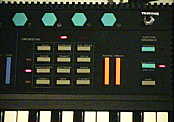 |
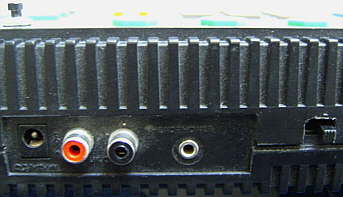
my replaced output jacks |
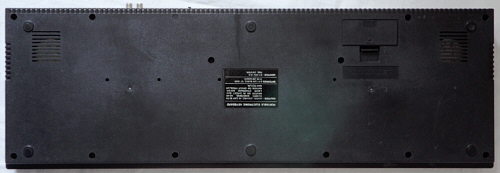 There is no model name on this keyboard.
There is no model name on this keyboard. |
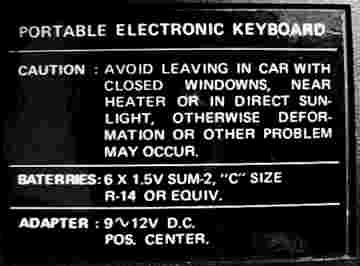 |
Like on C64 there are beside squarewave also sawtooth variants, but no VCF. A characteristic property of the employed DSG sound IC is that it mixes (by DAC impedance mismatch?) into brighter waveforms an undertone of plain squarewave toot with same pitch and constant amplitude, which produces a distinct sound that grows duller during decay and stops with a soft end click. All preset sounds are made from these barely filtered waveforms with simple volume envelope. They contain neither own vibrato nor tremolo and most of them sound not remotely like what their name suggests. But interesting for playing is that the 12 OBS preset sound buttons, "vibrato" and "sustain" can also be pressed while keys are held down without stopping their notes. By rhythmically pressing these buttons, this way many arpeggiator- like timbre changes can be created, thus this button field can be regarded as a realtime sound control, and unlike with many other digital instruments, the button field even responds almost immediately without delay.
The automatic accompaniment responds a little slowly, thus chord changes happen 1 rhythm step delayed in the exact sync of the rhythm; possibly this shall help beginners to sound more precise, but it also confuses and limits the expressivity. When in fingered mode with no rhythm (i.e. organ chords) multiple keys of a chord are pressed, the chord continues sounding until all of these keys have been released or a different chord is played; this prevents strummed/ chinked chords and other more advanced play tricks. 7th chords can't be played anyway due to the limited polyphony. (But remember, a C64 computer also had only 3 voice polyphony, and its low voice count event formed the particularly clearly structured music styles of it a lot, though this is not necessarily bad.) Great is that the automatic accompaniment also works well with any key combinations and does not force you only to play those few ones that establishment has defined to be "chords". The accompaniment simply plays the more simultaneous notes the more keys are pressed, which permits also great cacophonic patterns. (This is in no way a matter of course - see e.g. Yamaha PSS-390 for a bad example.)
The static voice assignment of the instrument is a little annoying, because in any chord modes only 1 polyphony channel remains for the user selected main voice in the right keyboard section, no matter how many channels are actually occupied with chords or other accompaniments. In manual bass mode even only 1 channel for the left (manual bass) and 1 for the right keyboard section remain; the 2 other channels don't get used at all. I first thought it layers multiple polyphony channels (sawtooth + additional squarewave) to synthesize the bass, but it was only a design flaw.
With the "custom drummer" feature you can program your own rhythm pattern
by first selecting a preset rhythm as a template of the desired step count
and then pressing "program" and entering step by step a sequence of drumpad
presses and pauses (="play/ space" button) until the lit "program" LED
unlights. You can also enter polyphonic sounds, although it needs some
training to press multiple drumpads fast enough together, because as soon
there are any barely audible pauses in between, they will be recorded as
multiple steps. (Programming can even be done while playing on the keyboard
and even with rhythm and/ or accompaniment on, but it is not a realtime
programming but takes as long as it needs to enter enough steps for the
pattern (up to 16), which makes this rather contra- intuitive for live
play.) Then press "play/ space" to start the programmed custom rhythm pattern,
which will play with the accompaniment of the previous preset rhythm when
accompaniment is enabled. The accompaniment for the custom pattern can
be changed by selecting a different preset rhythm and (re-)starting the
custom pattern by pressing "play/ space". An interesting pug (or easteregg?)
is that you can select this way different(!) pattern lengths for rhythm
and accompaniment, which makes run both out of sync like a poly- rhythm
and creates an interesting sound texture (i.e. accompaniment and rhythm
pattern both step with the same speed but restart independently by the
different step counts of both patterns).
circuit bending detailsThe MC-3 hardware class is based on the CPU "MC-3DX 153014" (crystal clocked @ 1MHz) with separate sound IC "DSG-MC-3 2191".
Most interesting is that the DSG seems to be identical with the Yamaha YM2163 soundchip that I found in Testron CL-60910 and various similar keyboards. I was e-mailed, that a variant in Letron MC3 case named Quasar apparently had a "933040" CPU with sound IC YM2163. Someone else mentioned a Fugison MC3-A (case unknown) with CPU "MC-3DX 3529154" and sound IC "DSG-MC-3 1194". These seem to be the YM2163
synthesis parameters of the preset sounds (visually identified by oscilloscope):
hum reductionIn the left speaker was much static noise audible due to the volume potentiometer was miswired in a way that it pulled instead of the power amp's input line the IC's sound output against GND; though the amp input stayed open which made it prone to pick up noise. (I don't know if this bug was just in my specimen or if all these keyboards contain it.) I swapped 2 of the pot cables to make it work like intended.
keyboard matrixMy old handwritten keyboard matrix plan was a mess, apparently based on (my own misunderstood?) Letron foil cable pinouts instead of CPU pinout. Unfortunately cables seem to vary among MC-3 variants, so I translated this to the standardized CPU pins and later re-analyzed the matrix to fix bugs and ensure that there are indeed no overlooked eastereggs. There aren't many, but the Letron MC-3 is crucial for understanding how Medeli implemented such things (especially for comparing with the predecessors HBATEC and Fujitone 3-A and successor Penrod AJ-430). So the absence of Angeltone hardware features (it supports neither the unique "Y/C" switch nor additional rhythms nor arpeggio) proves that the MC-3 is less related or the programmer ran out of memory (by adding the external sound IC and LEDs, or using a cheaper CPU?) and so had to eliminate unused features.my cable vs. CPU pins:
Like a typical Yamaha keyboard, the matrix layout is built in
12er groups sorted by notes and octaves.
The input lines are active-low, i.e. react on GND. Any functions can
be triggered by a non- locking switch in series to a diode from one "in"
to one "out" pin.
If absent in your variant, wire it through diode from CPU pin 1 to pin 35. Press it multiple times in chord mode to transpose the keyboard down (up to 11 semitone steps) to the intended key. schematicsThis is the schematics of a keyboard model Hua Li HLZ-4975, which is obviously an MC-3 version close to the Letron.pinout MC-3DX, SC-MC-3The "MC-3DX" (42 pin DIL) by Medeli is the CPU of the MC-3 series keyboard hardware class. A possibly earlier version was named "SC-MC-3" (seen in book "Keyboard Principle"). It has internal ROM, controls a squarewave sound IC "DSG-MC-3" and polls the keyboard matrix through 8 output and 12 input lines (active-low) and can control 22 panel LEDs though 3 additional outputs (need external transistors) multiplexed with the matrix. It is crystal clocked @ 1MHz and likely a generic microcontroller. But unlike the Zilog chips in predecessors made by Angeltone (e.g. HBATEC, Fujitone 3-A) I haven't identified which microcontroller it is based on, but many other 42 pin Medeli CPUs seem to be software variants of it.It was hard to find any info about this CPU, but finally I found a PDF of an obscure Chinese electronics book from 1990, which translated title appears to be "Keyboard Principle - use and maintenance" (ISBN 7-5053-1210-3/TN-360). Beside tech info about some early Casio and Yamaha home keyboards it contains schematics of various Chinese no-name tablehooters, including a "HLZ-4975" which is obviously an early version of Medeli MC-3 (same panel) with CPU named "SC-MC-3" and as DSG a genuine Yamaha YM2163. Unfortunately the text is Chinese (to me meaningless hieroglyphs), but fortunately component and pin names in schematics are readable. (Thanks Traktor for the tip.) Apparent software variants of the same CPU with external sound ICs are:
The same kind of 42 pin CPU was the heart of almost all MC-series squarewave keyboards. Likely these also include the entry level MC-2* keyboards (main voice polyphony 2 notes), those 4 MHz clocked CPU produces squarewave tones by itself. The normal models were clocked at 1 MHz like their employed DSG sound IC; only MC-38 was 4 MHz because its CPU additionally produces 3 squarewave tones (which indicates their technical relation). Later high grade variants already used an FM sound IC and so were clocked at 3.58 MHz. The CPU variants without sound ic (internal squarewave sound) are listed
separately, because pinout and software strongly differ:
It was a nightmare to identify the microcontroller type, because nothing normal had 42 pins with such a pinout. The pins 9..12, 21 and 42 are fix, the rest seem programmable I/O ports. The keyboard matrix pin order grouped by 4 may hint that it has 4 bit. Also the "SC-MC-3" pin names in "Keyboard Principle" suggest thus each port is 4 bit wide. Pins can be simultaneously in- and output (seen with MC-33 stereo pin) by switching internal pullup resistors hi or lo. Versions with internal (squarewave) sound generation are clocked at 4 MHz, others often 1 MHz. If this is a camouflage IC, by pin order I suspected a 4-bit microcontroller Toshiba TMP4720P or TMP4740P (used e.g. in the similar VTech Rhythmic 2) with the silicon die mounted wrongways and shifted by one pin. However supply voltage pins would be reversed and so have to contain an adapter and pin 12 made no sense. The specs page of the Chinese book "Keyboard Principle" claims that it was a Yamaha product, but I doubt because I found nothing with such a pinout in Yamaha keyboards nor (unlike the DSG) an original version with Yamaha label. (And it is not even 8-bit.) This is Traktor's translation of the description: "YAMAHA ultra-large-scale audio source integrated circuit SC-MC-3 SC-MC-3 is Japan's YAMAHA new single-chip 8-bit microprocessor circuit, with high-speed low-power performance. The circuit is made using MOS process. The internal package is a microprocessor CPU, which consists of a single-chip large scale integrated circuit composed of the central microprocessor, including a register, accumulator, arithmetic logic components, control components, internal bus and clock circuit. Microprocessor is also equipped with read-only memory (ROM), read and write memory (RAM), input-output interface circuit. With matrix scanning, scale signal formation, tone data processing, chord accompaniment function, automatic rhythm formation, reset and other functions...." But websearching the 2nd mode pin names of that book finally hinted to the "High speed and High performance 4-Bit Microcontroller" OKI MSM6404A-xxxRS or MSM6408-xxxRS. These contain 256 words (128 byte) RAM, have 8x 4-bit I/O port, 1x 4-bit input port, 3x counter (2x 12 bit, 1x 8 bit highspeed/timer), 8-bit serial I/O (hence the 2nd mode), 5 IRQ levels, 32 stack levels and fully static operation. Version MSM6408 has 8 KB mask rom, while the MSM6404A has only 4000 byte mask rom. (MSM6404VS is a development version with piggyback 8KB eprom socket. By OKI naming convention any names printed on the IC would likely begin with "M" instead of "MSM"). The pin names were taken from the "SC-MC-3" pinout in book "Keyboard
Principle" (typos fixed by OKI MSM6404VS datasheet) and line names chosen
by me to describe their functions (partly inspired by Casio naming conventions).
Interesting is that the pins have each a 2nd mode, which might be useful
for rom dumping.
The specs page in "Keyboard Principle" (translated by Traktor) describes these pin functions:
Maximum power consumption: 200 mWIn the Letron (MC-3) pins 13..16 seem to be unused input lines. They have high resistance hi level (4V) and do nothing when pulled against GND. The keyboard matrix outputs are multiplexed with panel LEDs (against pin 30..32). Keyboard matrix output pins 37, 40, 41 are wired through resistors. On the PCB the CPU pins to the DSG (17..20, 22..25, 33) have unused solder holes for pullup resistors. On my analogue scope, the clock rate is 7µs for 6 periods or 4x 0.3µs per period, which looks like 0.83 or 0.86 MHz. On the quartz stands "1000", which likely means 1 MHz. Pin 12 outputs clock spikes (rising sawtooth) with 4.7µs per period, which would be about 213 kHz; strange is that between these spikes seem to be some pauses (on scope visible as enclosed triangles) so in fact it may be even a fast serial data output. In First RAP-2 (MC-RAP-1) the data bus pins 20, 22..25 also control the sample percussion IC, which is selected through pin 31 and 32. The matrix out pins 34..37 also drive each a panel LED through a 2.7k resistor from +Vs; for this the pauses between the short scan pulses (when the inputs are active) are pulled lo to light the LED (else hi). Thompsonic TS-33 (MC-33) supports 2 DSG sound ICs, using CPU pin 32 as /SE to select the 2nd DSG. Pin 29 enables its stereo chorus; when set low (by a panel button in the keyboard matrix), it routes the analogue sound output of DSG1 to the left and DSG2 to the right stereo channel (using a 4066). The effect itself is software, sending each of the 4 polyphony channels simultaneously through both DSGs with phase shifted vibrato and tremolo. Strange is that the effect even activates itself (halving polyphony) when pin 29 is pulled low externally (possibly a slide switch was planned). Pin 31 outputs the trigger pulse for an external (analogue) base drum circuit. Letron MC-38 (MC-38) is clocked at 4 MHz because its CPU has 3 additional plain squarewave tone outs (2 of the chord channels + button click). Like MC-22 the level stays at the level (hi or lo) where the tone has stopped. Pins 26..29 control each a panel LED. GPM MC-5000 (SC-MC-5) is clocked at 3.58 MHz to drive the FM sound IC MC9003 at that speed. The panel leds are connected through transistors at pins 26..28 (spike frequency 111 Hz?) multiplexed with keyboard matrix out pins 34..41. Also the unused pin 29 has LED demux signal. Strange is that the keyboard matrix inputs pins 1..8 all produce output spikes even when no contact is closed. They are 2 spikes + gap in normal mode and 8 spikes + gap during demo. The gap width fluctuates, so there may be internal bus data accessible, but I guess it is rather a side effect of internal functions (e.g. resetting the port into output mode at start of a routine) than meaningful data. Who knows if there may be 7 segment display or even velocity sensing control pulses embedded, but the pattern looks too regular to do anything complex. Fujitone 6A (MC-68) has a very similar CPU clocked at 3.58 MHz to drive the FM sound IC "MC-9003A". The leds are multiplexed with keyboard matrix outs pin 34..42 and 3 additional pins using transistors; pin 26 selects the 8 panel leds, pin 27, 28 the digit 1 and 2 of the optional 7 segment led display. The unused pin 29 was apparently intended for a rhythm select button led. Pin 31 activates the optional analogue stereo chorus circuit; it starts hi (off?) and toggles by every press of a certain (omitted) panel button. Also here the keyboard matrix inputs 1..8 have output spikes on them, although they are not used for any led outputs (verified by shorting to GND). Also the SC-MC-2 CPU
of the MC-2 hardware class (Fujiyama KS-37)
is likely based on MC-3DX, but since it is clocked on 4 MHz and has at
least strong software differences for its crude internal 2 channel tone
generator, I treat it as a separate IC with own pinout. A variant with
even more internal squarewave channels (2 melody or 1 melody + 2 chord,
+ button click) is the MC-22
(Elite MC2200). The MC-38 CPU (Letron
MC-38, 4 MHz) is an odd cross between MC-3DX and MC-22, because
it has as well the DSG sound as 3 internal squarewave tone channels (2
chord channels + button click). Due to strong pinout similarities I list
it here although it may be technically closer to the MC-22. The only DSG
based MC-series keyboard with completely different CPU (MC25-1)
was Pan Toys MC-73; it is unknown
why the different CPU (despite same pin count and clock rate) was used.
Possibly the chip could not be made anymore because the chip factory changed
its manufacturing process.
pinout DSG-MC-3The Digital Sound Generator "DSG-MC-3" (24 pin DIL) is a clone of Yamaha YM2163 (see there), used in various Medeli keyboards.The DSG can re-route polyphony channels to switch them among main and chord voice outputs. In MC-3 keyboards it outputs the following pre-mixed analogue signals:
The DSG can share its 4 polyphony channels among 4 output lines, those are externally mixed through resistors. So main and accompaniment voice are finally summed into 2 different outputs for independent volume control pots. Because the audio outputs are high impedance and thus have strong crosstalk from this mixer, and some had massive HF ripple on them, it was next to impossible to identify which channel is output where, and also the waveforms didn't resemble the YM2163 datasheet. Cutting the PCB traces at DSG pins 2..5 (later soldered back) revealed that each polyphony channel is at any time output only through one pin as open-collector current (needs pulldown resistor). By the strong HF ripple I first thought that lower DAC bits were PWM, but it turned out that on each pin the 4 polyphony channels are time multiplexed analogue signals (an absent or mute channel stays zero) with high resistance sections in between. Normally in Letron MC-3 pin 3 is wired through a 100nF capacitor against GND and pin 5 through 47nF, which made the ripple disappear and smoothened the waveform. Pin 3 is wired only through 100 Ohm to such a cap, which showed on top of the smoothened waveform a bizarre magnified comb pattern following its curve, because in the high resistance gaps the smoothened waveform voltage leaks through from the capacitor. Pin 5 has no cap near it. Without muffling capacitors, the coarse digital blocks in the waveforms get clearly visible. E.g. the Testron has no capacitors at its (genuine Yamaha YM2163) DSG and so at pins 2..5 the crisp blocky shapes from the Yamaha datasheet can be seen. I am not sure if the DSG contains a VCA with internal envelope capacitors, because although it doesn't sound really analogue and there are stair steps, I discovered an odd behaviour in my Penrod AJ-430, which has an identical sounding sound generator integrated into its CPU CIL-51 that makes odd envelope glitches at too high supply voltage, which hints to the existence of such internal caps with PWM transistors making mess. By its datasheet the original YM2163 is fully digital. |
Keyboards with this hardware exist in a variety of different cases and were sold under many brand and model names (often containing "MC-3"). They can be recognized best by their "500 Miles Away From Home" demo tune (only 1 demo, which cycles through all instrument sounds). Other characteristic elements are 12 sound + 8 rhythm buttons, 5 drum pad buttons and a "custom drummer" section with the very distinctive "play/space - cha cha" button. They also have an "A. B. C. volume" slider and a "manual bass" button in the "auto bass chord" section. I assume that the electronics was originally designed by the Chinese manufacturer Medeli. According to their website, Medeli Electronics Co.,Ltd. was founded in 1983 and first made a Chinese word processor. Their first successful keyboard was the MC-3A released in 1988; they sold over a million of them to 90 countries.
I bought this keyboard on eBay because the box photo showed different sound button names and "5A" had no "3" in it. But it turned out to be only yet another plain MC-3 and the box photo apparently depicted a fake prop that had no model name, "arpeggio" instead of "manual bass", sounds in different order and many rhythm and demo control button names blackened. On the keyboard drawing in the manual the locations of "transposer" and "reset" button are swapped with "sustain" and "vibrato" (layout differs from the instrument itself). The case has many style elements common with the Penrod AJ-430. I am not sure whether it was released by Kawasaki at all (they rather made colourful toy keyboards and professional drum kits and e-guitars) or just counterfeit (as the box text "JAPAN DESIGN" and lack of manufacturer info in the manual suggests). But the generic yellow-blue box design with pink stripe is typical for early Medeli/ MC-series keyboards.
My specimen also was broken (despite sold as functional). Rhythm was mute by a dead electrolytic cap, the 5V voltage regulator output too high (this can destroy the CPU when using a 12V PSU =>transistor replaced, zener diode resoldered) and the left speaker distorts by fried voice coil. The PCB type "3PK-2B, ZXB 9205" hints that it was likely also used in the GPM MC-3PK. At least it features the "transposer" and "reset" buttons those were omitted on the Letron.

The box photo shows a dummy. |
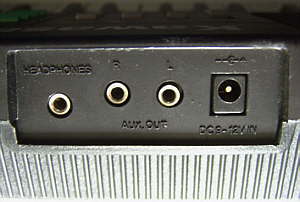 |
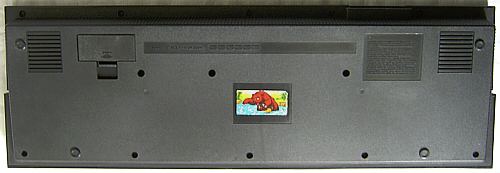 |
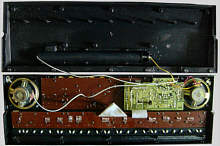 |
 The PCB is smaller by the lack of LED drivers and includes the slide potentiometers.
The PCB is smaller by the lack of LED drivers and includes the slide potentiometers. |

Letron same case:
*) I am not sure about Eurotone 3B; someone described it at the phone ("5 green drumpads" etc.) but I neither saw nor heard it. |

Fujitone M/3A (note the bigger drumpads and less LEDs) same case:
*) contains no MC-3 hardware. |

Fujitone IIIB same case:
|
 Transtec 898
Transtec 898
same case:
|

GPM MC-5000* same case:
*) contains no MC-3 hardware. |

(CRM-Toys) GPM MC-3PK same case:
|
 
Xinjian XJ49F-1 (photos from of Chinese websites, shown for educational purpose) |

Huaxin H-100 |

Westlake DZQ49A |
A direct successor of MC-3 was the Letron
MC-38 and a more advanced and programmable one the Thompsonic
TS-33. A technically simplified MC-3 variant was released as Penrod
AJ-430 (no separate sound chip, only 2 volume sliders, great accompaniment,
2 demos).
| removal of these screws voids warranty... | ||
 |
||
|
|